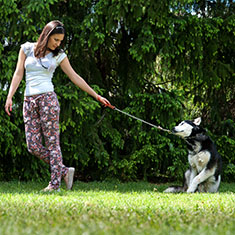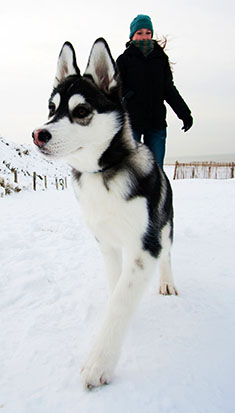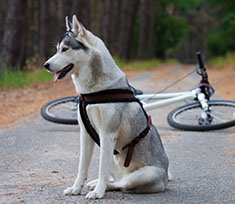Exercising the Siberian Husky Safely: Harness Training
New Siberian Husky owners soon begin to grasp the challenge of providing a safe way to exercise their dogs. As the Siberian Husky is extremely independent and the breed has a well-developed hunting instinct, exercising a Husky off leash in an unfenced area can be extremely risky. Many Huskies have become lost or met untimely deaths from chasing game, pursuing livestock, or simply dashing across a busy road to check out a dog on the other side. They should therefore always be kept on a sturdy leash when outside of a well-fenced property.

However, the sled dog instincts of the Siberian Husky are also very strong. Even though they can be educated to walk on a leash without dragging the owner, their natural inclination is to run and to pull. They are happiest when given the opportunity to do so, and will be calmer and healthier if they can be exercised in harness.
Puppy Harness Training
Teaching the Siberian Husky puppy to work in harness is done in several stages. The first one can begin when the puppy is about four months old, using a well-fitting and comfortable harness of any type and a nylon cord attached with a snap to the harness as a “tugline”. The harness should be adjusted correctly so that the pressure is on the shoulders and not the back, and the harness does not choke the puppy in any way. The puppy is not required to pull a load at this age as this can adversely affect the development of his bone and tendon structure. To get the puppy used to the harness, it can be put on just before feeding or play. The pup should be gently but firmly discouraged from chewing on the harness and distracted if necessary until he has accepted the feel of it. This will not take long and soon the puppy can be taken for walks while wearing his harness.
A word of caution: ANY exercise or training should take place in cool temperatures (preferably well below 60° F/ 15° C) as otherwise the dog could seriously overheat, and water should be kept on hand to provide if needed and after exercising the dog.
Training sessions must be fun, though the puppy must also be encouraged to be serious in harness. First, the puppy should be walked with collar and leash and allowed to relieve himself and relax. Then the harness can be put on and the tugline attached to the harness. Care should be taken to ensure that the puppy does not back out of his harness, as this could become a dangerous habit, and a small cord can be run from harness to collar just in case the pup does slip the harness. The trainer should then encourage the puppy to walk or trot in front of him, keep the leash taught, and not stop to sniff at the side of the trail or play with the tugline, for example. This should remain a pleasant activity for the puppy so the trainer will need to be patient and positive.

Taking turns
When the puppy has learned to move forward correctly and without stopping to sniff along the way, he can then be taught to turn right or left on command. Reins are not used to drive sled dogs, and the Husky must learn to change directions on voice commands only. “Gee” for “right” and “Haw” for “left” are the traditional turn commands, but any command the trainer wishes to use will suffice as long as it is used consistently. Directions can be taught in several ways while training the puppy on foot. It is best to do this on a trail or road that has clearly defined intersections. A light cord can be attached to the puppy’s collar and gentle tugs in the direction the trainer wants to turn can be associated with the command. Another technique is for the trainer to walk into the turn, repeating the command, until the puppy goes in the right direction and stays in front. Praise and petting should be lavish when the pup executes the order, even if at first it might take several repetitions. It is recommended to begin with only one direction, for example, “right”, and when the puppy has mastered that command, he can be taught to turn in the other direction. After that, it will be necessary to practice both directions alternatively until the puppy has mastered the difference. If the training is kept fun, the puppy will learn quickly. From there other commands can be taught, one at a time, such as “turn around” or commands to run faster or slow down, etc.
One thing the trainer should remember is that the less said, the better the dog will listen. Chattering, and a fortiori shouting, at a dog for the entire training session is counter-productive as he will soon no longer be able to distinguish a command from other vocalizations. Moreover, shouting at the dog or dog team is considered extremely poor trail etiquette and is disrespectful not only to the dog team but to other trail users and disturbing to the wildlife living in the area.
Pulling a load
When the puppy is about six months of age, it is possible to teach him to pull a light “load.” Pulling a bicycle or light motorcycle tire is a good way to start. The tire can be attached to the harness with a cord, and the trainer will also keep the tugline on the harness to control the puppy. Again, positive reinforcement and much praise will soon make the puppy a willing worker.

As the puppy grows, the harness will have to be changed or adjusted to fit. Once the pup has reached his adult size, it is wise to invest in a good quality harness. There are several types of harnesses but the main point is that the one used should fit the dog properly. It should be snug but not too tight with the thickness of the dog’s coat taken into account when fitting. The harness should be well adjusted and comfortable around the shoulders, with protective padding, and not cut off the dog’s breathing when he pulls. It should also be the proper length and not place undue pressure on the dog’s ribs, spine or hips. Good harnesses are now made of nylon webbing and are easy to care for and machine washable. If the dog has been taught not to bite or chew the harness and it is cared for properly, it can last well beyond the dog’s entire working career. There are many good sled dog harness makers online, and sled dog sports clubs can be contacted for advice and assistance in obtaining the right harness for the dog.
Exercising with your Husky
Once the dog is working correctly and seriously in his harness, he can be exercised safely on foot with the owner jogging behind. This activity is often called “cani-cross”. Exercise can also be provided using a bicycle (“bikejoring”) or on cross-country skis (“skijoring”). The owner will certainly enjoy this activity as much as the Husky does, and may even wish to move on to the competitive sled dog sports level. At any rate, the fun and complicity derived from training and working with the Husky will develop a very close bond between owner and dog. However, this often has another effect … and that is… the owner and dog may be having so much fun that in no time at all other dogs will be added to make up a complete team!
You can find out more about training your Siberian Husky in our article "Siberain Husky Training Basics"
Doggies Den: Latest Articles
 Homemade Thanksgiving Treats for Your Dog
Homemade Thanksgiving Treats for Your Dog
NUTRITION We all want to include our dogs in our holiday celebrations, but hopefully, you're aware that sharing table scraps with your dog isn't always the best idea.
 Keeping Your Dog Safe during the Summer Months
Keeping Your Dog Safe during the Summer Months
HEALTH Summer is coming on fast, so it’s time to plan how you will keep your dog safe and healthy through the lazy, carefree, warm days.
 Vaccination Time Again-Keeping Your Puppy Healthy
Vaccination Time Again-Keeping Your Puppy Healthy
DOG HEALTH So you have your new puppy picked out. There are quite a few shots, treatments and examinations that will keep the newest member of your family healthy.
 Canine Thanksgiving Feast
Canine Thanksgiving Feast
NUTRITION With the wide variety of food at Thanksgiving dinner, chances are you'll want to give your dog something special, too. If you're contemplating what to feed your dog for the holiday, here is a guide to a great Canine Thanksgiving Feast.
 Dog Walking Tips Every Owner Should Know
Dog Walking Tips Every Owner Should Know
DOG FUN Walking your dog is not only crucial to keeping him healthy and happy, it strengthens the bond between your canine friend and his caregiver. There are a lot of obstacles out there. Don’t forget these simple tips to keep your walk fun and safe in the outside world.
 The Benefits of Physiotherapy for your Dog
The Benefits of Physiotherapy for your Dog
HEALTH The same techniques that physiotherapists use to treat a variety of injuries and conditions in humans have been adapted to suit animals with great success. Family pets, show dogs, and working dogs can all benefit greatly from physiotherapy. Dogs whose activities involve a lot of agility are especially susceptible to the types of problems that physiotherapy can address.
 The Decision- Adding a Dog to Your Family
The Decision- Adding a Dog to Your Family
FIRST TIME OWNERSBringing a dog into your family is a decision where many people don’t realize it’s magnitude until after they have the dog. There are a number of things that you need to research before you decide to purchase a dog, and it starts right in your own home.
 Bringing Your Dog Into Your New Baby's Life
Bringing Your Dog Into Your New Baby's Life
HEALTH Many believe that a dog and a new baby cannot happily coexist, so therefore the dog has to go. This is not necessarily the case.  A new baby does not mean you have to abandon your dog.

Doggies Den:
Most Popular Articles

Dog Pregnancy Symptoms
HEALTHIf you suspect your dog might be pregnant, check out part one in this series on pregnant dogs, where we cover pregnant dog symptoms.

Dog Birth
HEALTHIn the third article of our dog pregnancy series, we look at the wonderful, but messy, process of bringing newborn puppies into the world.

Indoor Dog Potties
DOG PRODUCTSIt's been a long day at work. You were so busy, you didn't even take time to eat a sandwich, let alone run home to let your dog out. You're on your way home, knowing the poor dog is crossing his or her legs by now, when your car breaks down, delaying you even further. Can't somebody make this easier?

Your Dog’s Digestive System
PHYSIOLOGYEver wonder why your dog eats so fast? Or why he eats gross things? Or why he gets sick to his stomach? Or why his waste stinks so bad? Some of these things are normal, some are not.

Canine Respiratory System
BREATHINGThe basic function of your dog's respiratory system is to bring oxygen in to and remove carbon dioxide from the body. Knowing the symptoms of respiratory diseases can help you help your stay healthy.

Shelter Dog Adoption Tips for Success
ADOPTION Are you intimidated by the prospect of "rescuing" a dog from a shelter? One reason that you may be wary of adopting a dog from a shelter is not knowing how to choose. Adopting a dog from a shelter can be a rewarding process, if you're prepared to do a reasonable amount of research.

Canine Urinary Tract Infections
SYMPTOMS AND TREATMENTDoes your dog seem to be having trouble relieving his or her bladder? Learn how to recognize the signs of urinary tract infections and how to treat them before they spread.

What to do for Dog Diarrhea
SYMPTOMS AND REMEDIESIf you have dogs in your house for any length of time, you have likely experienced at least one bout of dog diarrhea. Beyond the pain in the tuckus involved in cleaning up the mess, you should know what causes diarrhea, and when it's important to see the vet.

What to do for a Dog Bite
DOG BEHAVIOR Getting bitten by a dog can be scary, and you may be tempted to run around in circles for a while, trying to figure out what to do. Here's our guide to help you manage the situation.

Top Ten Tips for Living with a Senior Dog
DOG HEALTH Bringing home a new puppy is so exciting, but it doesn’t take all that long for your exuberant puppy to grow into a senior dog who may have special needs. Here are the doggies.com top ten tips for taking care of your companion who has been with you through so much.
